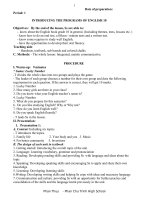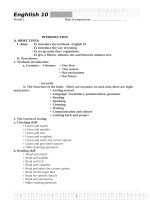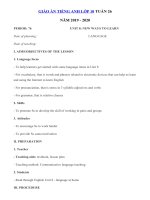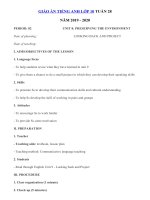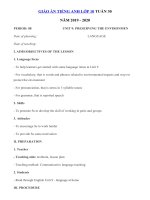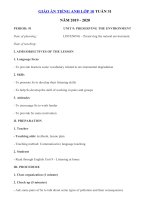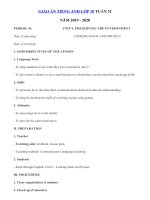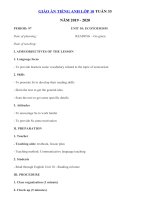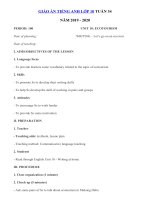Giáo án tiếng anh lớp 10 sách global success (kì 1)
Bạn đang xem bản rút gọn của tài liệu. Xem và tải ngay bản đầy đủ của tài liệu tại đây (10.54 MB, 340 trang )
GIÁO ÁN TIẾNG ANH 10 – GLOBAL SUCCESS - KỲ I
UNIT 1: FAMILY LIFE
Lesson 1: Getting started – Household chores
I. OBJECTIVES
By the end of this lesson, Ss will be able to gain:
1. Knowledge
- an overview about the topic Family life;
- vocabulary to talk about household chores.
2. Core competence
- develop communication skills;
- be collaborative and supportive in pair work and teamwork;
- actively join in class activities.
3. Personal qualities
- be aware of responsibilities towards family
II. MATERIALS
- Grade 10 textbook, Unit 1, Getting started
- Computer connected to the Internet
- Projector/ TV/ pictures and cards
- sachmem.vn
III. PROCEDURES
Notes:
In each activity, each step will be represented as following:
*
Deliver the task
**
Implement the task
***
Discuss
**** Give comments or feedback
Stage
Stage aim
Procedure
1
Intera Ti
ction me
WARMUP
- To introduce GAME: LET’S RACE!
the unit topic * T divides Ss into 4 groups and
(Family life); gives instructions: Watch the video
- To introduce clip and try to remember all the
household chores Mr. Bean did in the
some
video. One person from each group
vocabulary
then goes to the board and writes the
and the
names of the chores.
grammar
points to be
learnt in the
unit.
T-S
5
mi
ns
** Ss do as instructed.
*** Ss work in pairs to discuss the
answer after watching the clip, then
one representative from each group
writes the answer on the board.
**** T confirms the correct answers.
Suggested answer:
1. Mop the floor
S-S
S-S
T-S
2. Clean the toilet
3. Wash the clothes / Do the
laundry
4. Clean the house
5. Vacuum the carpet
PRESEN To help students VOCABULARY
TATION use key
* T asks Ss to look at the photos to
language more guess the meaning of new words.
appropriately
before they read
and listen.
2
T-S
4
mi
ns
** Ss say the Vietnamese meaning of
the word.
1. household (n) /ˈhaʊs.həʊld/
2. chore (n) /tʃɔːr/
*** Other Ss correct if the previous
answers are incorrect.
**** T shows the Vietnamese
meaning, says the words aloud and
asks Ss to repeat them.
PRACTI - To get students TASK 1. LISTEN AND READ
CE
interested in the (p.8)
topic.
* T asks Ss to look at the picture (p.8
- To get students - 9) and answer the questions:
to learn some
● Who are
vocabulary in
they?
the unit.
● Where are
they?
T-S
● What are
they doing?
** Ss do the task individually
*** Ss share their answers with a
partner.
**** T checks their answers with the
whole class.
Suggested answers: Nam and Minh
are two friends. They are at Nam’s
home. Nam is cooking.
3
S
S-S
6
mi
ns
* T has the Ss read the conversation
in pairs.
T-S
** Ss read the conversation
*** One pair reads aloud.
**** T collects common mistakes
and gives comments.
TASK 2: TRUE OR FALSE
To practise
reading for
specific
information
- To practise
scanning
- To develop
students'
knowledge of
vocabulary for
household
chores
Read the conversation again and
decide whether the following
statements are true (T) or false (F).
(p.9)
T-S
S-S
S-S
T-S
10
mi
ns
* T asks Ss to work individually to
read the statements and underline the
key words, then share their ideas
with a partner who sits next to them.
T-S
** Ss do Task 2 individually first.
S
*** Ss share and discuss with their
partners about the key words
S-S
T-S
**** T corrects their answers as a
class.
1. Nam’s mother is cooking now.
2. Everybody in Nam’s family
does some of the housework.
T-S
3. The children in Minh’s family
don’t have to do any
housework.
S-S
* T asks Ss to scan the conversation,
locate the key words to find the
answer for each the question with the
partner who sits behind them
** Ss do the task in pairs.
**** T has Ss share their answers
with the class. T confirms the correct
4
T-S
answers and have Ss correct the false
statement. T writes the correct
sentence on the board.
4
mi
ns
Key:
- To help
students revive
some
collocations for
the household
chores so that
they can use
them in the
following
lessons.
1. F → Nam is cooking now.
2. T
3. T
TASK 3: FILL IN THE TABLE
Write the verbs/verb phrases that
are used with the words or phrases
in the conversation in 1. (p.9)
T-S
S
S-S
T-S
* T has Ss locate the verbs or phrasal
verbs in the conversation, find the
- To help
students practise nouns or noun phrases after each
verb/ phrasal verb to do the
scanning.
matching.
** Ss work individually
*** Ss share their answers with a
partner
**** T checks and gives the correct
answers with the whole class, and
has them say the meaning of each
collocation.
Answers:
T-S
1. put out the rubbish
2. do the laundry
To help students
identify present
simple and
present
continuous and
how they are
used in
S
3. shop for groceries
S-S
4. do the heavy lifting
T-S
5. do the washing-up
5
4
mi
ns
sentences
TASK 4: COMPLETE THE
SENTENCES.
Complete the sentences from the
conversation with the correct
forms of the verbs in brackets.
(p.9)
* T has Ss read each sentences, try to
think of a verb or an auxiliary verb
that will complete the gap.
** Ss do the task individually
*** Ss share the answers with a peer.
**** T asks the whole class to call
out the verb forms first, then calls on
individual students to read the
complete sentences.
Answers:
1. ‘m preparing
2. does – ‘s working
PRODU - To help students
CTION practise talking
about activities
which raise
students’
awareness of
their
responsibilities.
- To practise
teamworking.
- To give students
authentic
practice in using
target language.
TASK 5: MAKE A POSTER!
Think about activities which you
can do to raise other students'
awareness of their responsibilities
towards their family.
8
mi
ns
T-S
* T gives Ss clear instructions in
order to make sure Ss can do
effectively.
- Divide Ss into 4 main groups .
- Ask Ss to work in groups to discuss
and make a poster of activities to
raise Ss' awareness of their
responsibilities towards their family.
- Observer Ss while they are
discussing, note their language errors
** Ss do as instructed
6
S-S
T-S
**** T gives Ss feedback.
- Choose some useful or excellent
words/ phrases/ expressions/ word
choices Ss have used to give
suggestions to other students.
- Choose some typical errors and
correct as a whole class without
nominating the Ss’ names.
CONSO - To help students
LIDATI memorise the
ON
target language
and skills that
they have
learned
- To inform
students what
the final product
of the project
should be and
how students
can prepare for
it.
WRAP-UP
* T asks Ss: What have you learnt
today?
- Some lexical items about household
chores
- Reading for specific information
- Scanning
HOMEWORK
1. Exercises in the workbook
2. Project preparation
- Have Ss look at the last page of
Unit 1, the Project lesson and ask
them what topic of the project is.
- Tell them the project requirements:
Do research on Family Day in Viet
Nam or other countries in the world
+ suggest activities, provide the
reasons and expected results of the
activities;
+ present their plans in the last lesson
of the unit.
- Remind Ss that besides
brainstorming activities, they:
+ can search for ideas on the Internet,
in the newspaper, etc. for reference.
7
T-S
4m
ins
+ should use photos/pictures to
illustrate their ideas.
- Put Ss into groups and have them
choose their group leader. Ask them
to assign tasks for each member,
making sure that all group members
contribute to the project work.
- Help Ss set deadlines for each task.
UNIT 1: FAMILY LIFE
Lesson 2: Language
I. OBJECTIVES
By the end of this lesson, Ss will be able to:
1. Knowledge
- Pronounce the consonant blends /br/, /kr/, and /tr/ correctly in individual words
and in sentences;
- Understand and use some lexical items about family life;
- Distinguish and use present simple and present continuous.
2. Core competence
- Be collaborative and supportive in pair work and team work
- Access and consolidate information from a variety of sources
- Actively join in class activities
3. Personal qualities
- Be aware of responsibilities towards family
II. MATERIALS
- Grade 10 textbook, Unit 1, Language
- Computer connected to the Internet
- Projector/ TV/ pictures and cards
- sachmem.vn
III. PROCEDURES
8
Notes:
In each activity, each step will be represented as following:
*
Deliver the task
**
Implement the task
***
Discuss
**** Give comments or feedback
Stage
WARMUP
Stage aim
Procedure
- To arouse the GAME: Guess the words
classroom
* T gives instructions:
atmosphere.
• There are 8 pictures related to
- To lead in
the topic “Family life”.
the lesson
• Ss have 5 seconds to think, then
guess the word corresponding to
the picture.
Intera
ction
Time
5 mins
T-S
S-S
+ Correct answer � +1
+ Wrong answer � -1
T-S
**** T counts the points, decides the
winner, asks some more questions and
leads in the lesson.
PRONUN To help students
CIATION recognise and
practise the
consonant
blends /br/, /kr/,
and /tr/ in words
TASK 1. LISTEN AND REPEAT.
5 mins
Pay attention to the consonant
blends /br/, /kr/, and /tr/ (p.9)
* Teacher:
T-S
- plays the recording and asks Ss to
listen to the words and repeat; tell
them to pay attention to the consonant
blends. (T can play the recording as
many times as necessary)
- makes sure Ss know the meaning of
each word.
** Ss do as instructed.
9
S-S
T-S
**** Teacher checks whether Ss have
improved their pronunciation by
randomly calling on individual Ss to
read the words aloud.
T-S
(Teacher can also play the
pronunciation video lesson of this Unit
for students to watch before they do
the task.)
To help students
practise
identifying the
consonant
blends /br/, /kr/,
and /tr/ in
sentences.
TASK 2: LISTEN TO THE
SENTENCES AND CIRCLE THE
WORDS YOU HEAR. (p.9)
5 mins
T-S
* Teacher:
- asks Ss to read all the words once,
paying attention to the different
consonant blends in the words in each
group; checks that Ss understand what
the words mean.
- plays the recording for Ss to listen
and circle the words with the
consonant blends they hear.
- has Ss work in pairs to compare their
answers; checks answers by asking
individual Ss to read out the words
they have circled.
- plays the recording again, pausing
after each sentence, for Ss to repeat.
** Ss do as instructed.
*** Ss practise reading the sentences
in pairs
**** T goes round to offer help and
collect common mistakes to correct as
a class.
Key:
1. b
10
S-S
S-S
T-S
2. c
3. a
VOCABU To make sure
LARY
that students
understand the
meaning of
some lexical
items about
household
chores.
TASK 1: MATCH THE WORDS
WITH THEIR MEANINGS. (p.10)
4 mins
* T gives clear instructions
T-S
** Ss work in pairs to discuss and do the
matching
S-S
*** Ss share the answers with the whole
class.
T-S
S-S
**** T confirms the correct answer
Key:
1. b
2. d
3. e
4. a
5. c
To give studentsTASK 2: COMPLETE THE
practice in
SENTENCES USING THE
using the
WORDS IN TASK 1. (p.10)
words/phrases * Teacher:
in meaningful
- has Ss work in pairs; tells them to
contexts.
read the sentences carefully and
decides which word in task 1 can be
used to complete each of the
sentences. T explains that they should
use the context clues to decide on the
word / phrase, e.g. ‘my mother’ in
sentence 1 refers to a person.
5mins
T-S
- checks answers as a class, then has Ss
call out the word they have used in
each sentence first.
- confirms the correct answers. T asks
Ss to give reasons why they have
11
S-S
S-S
chosen the word for each sentence, e.g.
what context clues they have used.
T-S
- asks some Ss to read the complete
sentences.
** Ss work in pairs to discuss and find
the answers
*** Ss share the answers with the whole
class
**** T confirms the correct answers and
asks Ss to give the reasons why they
have chosen the word/phrase for each
sentence.
Key:
1. homemaker
2. groceries
3. heavy lifting
4. housework
5. breadwinner
GRAMM To give students
AR
an opportunity
to revise the use
of present
simple and
present
continuous
TASK 1: CHOOSE THE CORRECT
FORM OF THE VERB IN EACH
SENTENCE. (p.10)
* Teacher:
- tells Ss to read the sentences in 4 in
Getting Started. T asks them what
tense(s) is / are used in each of them.
For example, What does Nam say?
Why is he using that tense? (Nam
says, ‘I’m preparing dinner’. He uses
the present continuous tense because
he is talking about what he is doing at
the moment of speaking.)
- in weaker classes, has Ss read
through the Remember! box and
checks understanding of the grammar
12
15 mins
T-S
points. T asks some questions to elicit
more examples from Ss, e.g. What are
you doing now? (I’m sitting at my
desk. I’m learning about … I’m taking
notes.) What do you do every day? (I
watch TV. I play computer games. I
have breakfast, lunch, and dinner.) - in
stronger classes, ask Ss when we use
each tense and elicit answers without
having Ss read the Remember! box.
Then T puts them into
groups to go through the explanations
and checks if their answers are correct.
- asks Ss to work in pairs or
individually to choose the correct form
of the verb in each sentence. T
explains that they can use some clues
in the sentence to decide on the correct
tense form such as adverbs of
frequency or phrases of time, e.g. 1:
usually; 2: now; 3: every day; 4: today;
5: twice a week.
S-S
S-S
T-S
- checks answers and asks Ss to
explain their choices (using the clues
above).
** Ss do as instructed
*** Ss share their answers with a
partner
To give students
a further
opportunity to
revise the use of
present simple
and present
continuous.
**** Teacher check Ss’ answers and
asks them to explain their choices
(using the clues above).
Key:
T-S
1. does
2. is putting out
3. cleans
13
4. is studying
S-S
5. does
S-S
T-S
TASK 2: COMPLETE THE
PARAGRAPH.
Read the text and put the verbs in
brackets in the present simple or
present continuous.
* Teacher:
- T asks Ss to look at Remember! box
again to master the differences
between Present simple and Present
continuous.
- T asks Ss to work individually.
** Ss do as instructed.
*** Ss share their answers with a
partner.
**** T check Ss’ answers and asks
them to explain their choices (using
the clues above).
Key:
1. does
2. is not/isn’t doing
3. is watching
4. are doing
5. is tidying up
6. is trying
14
EXTRA
ACTIVIT
Y
To help students GAME: 20 questions
further practise * T explains the rules of the game.
the present
* Ss do as instructed
tenses forms.
**** T praises Ss for interesting ideas
and having a good memory and
decides the winner.
4 mins
T-S
S-S
T-S
Rules:
1. Ss are given a list of words
related to the topic: Family life.
2. Ss ask each other using Present
Simple and Present Continuous
Yes/No questions until they
guess which of the words their
partner chose.
*Possible questions include “Are you
doing this now?”, “Is anyone in this
class doing this now?”, “Are many
people in this city doing this now?”,
“Do you do this every day?” and “Do
you do this more than twice a week?”
CONSOLI To help students
DATION memorise the
target language
and skills that
they have learnt
WRAP-UP
* T asks: What have you learnt today?
- consonant blends /br/, /kr/, and /tr/
- some lexical items about household
chores;
- present simple vs. present continuous
HOMEWORK
- Exercises in the workbook
- Prepare for lesson 3 Unit 1.
UNIT 1: FAMILY LIFE
15
T-S
2 mins
Lesson 3: Reading
I. OBJECTIVES
By the end of this lesson, Ss will be able to:
1. Knowledge
- Read for specific information in a text about the benefits of doing housework for
children;
- Understand the topic-related words introduced in previous lessons;
- Use the topic-related words in meaningful contexts
2. Core competence
- Be collaborative and supportive in pair work and team work;
- Access and consolidate information from a variety of sources;
- Develop presentation skill;
- Actively join in class activities.
3. Personal qualities
- Recognise the benefits of doing housework for children
- Sharing housework with their families
II. MATERIALS
- Grade 10 textbook, Unit 1, Reading
- Computer connected to the Internet
- Projector
- PowerPoint
III. PROCEDURES
Notes:
In each activity, each step will be represented as following:
*
Deliver the task
**
Implement the task
***
Discuss
**** Give comments or feedback
Stage
Stage aim
Procedure
16
Inter Tim
actio e
n
WARMUP
- To arouse the
classroom’s
atmosphere
- To lead in the
lesson
GAME: Who’s in charge?
7
T - S min
s
* T divides the class into groups of four,
has Ss discuss in groups and list down
(as much as possible) the housework that
they think mom, dad and kids usually do
in 3 minutes. T explains that after Ss
finish their discussion, one representative
from each group comes and writes their
S-T
lists on the board. T reminds Ss that the
-S
1st group to finish will say “STOP THE
BUS” and the others have to stop
writing.
T-S
** Ss discuss in their teams and list down
the housework. One representative from
each group comes and writes on the
board.
**** T confirms, checks the answers on
the board, decides the winner and leads
in the lesson.
Suggested answers:
Mom: cook, do laundry, wash dishes,
clean the house, …
Dad: do heavy lifting, fix the roof, cook,
wash dishes, …
Kids: take out trash, tidy their room, fold
the clothes, …
PRETo introduce the Task 1. LOOK AT THE PICTURE
READIN topic of the
AND ANSWER THE QUESTIONS.
G
reading and get (p.11)
students
involved in the
lesson
17
5
T - S min
s
*
T sets the
context for the reading tasks, asks some
questions about the picture and has Ss
call out the answers as a class.
S
Suggested questions:
T
Is this a family?
Who do you think they are?
Where do you think they are?
T asks Ss to work in pairs, look at the
picture and answer the questions.
T tells Ss that there are no right or wrong
answers and they should feel free to
make any guesses.
** Ss answer the questions.
**** Teacher confirms, shows the
answers on the screen.
Suggested answers:
1. The mother is cooking; the father is
laying the table; the son is (vacuuming)
cleaning the floor; the daughter is
washing vegetables.
2. The people are happy because they
are doing housework together, and all
the family members are sharing the
household chores.
WHILEREADIN
G
To help students
practise
guessing the
meanings of
words in
context
TASK 2: READ THE TEXT AND
TICK ( ) THE APPROPRIATE
MEANINGS OF THE
HIGHLIGHTED WORDS. (p.11)
* Teacher:
- asks Ss to read the whole text once to
get an overall idea; asks Ss to go through
the two options for each word and check
18
T-S
6
min
s
understanding; has Ss read the text again;
tells them to pay attention to the context
of each highlighted word, and look for
S-S
context clues conveying the meaning of
the word.
- asks Ss to work in groups to discuss the
clues for each correct option and
compare their answers.
T-S
** Ss discuss in groups to find out the
answers and raise their hands to give the
answers.
*** T confirms, shows the answers on
the screen and asks Ss to make
corrections if they choose the wrong
answers.
Key:
1. a
To help students
understand the
lexical items in
the text
2. b
3. a
4. a
5. b
VOCABULARY
5
* T has Ss read the text again, and pay
T - S min
s
attention to the highlighted words. T asks
Ss to define the word based on the
context and give the Vietnamese meaning
S-S
of each word.
** Ss read the text again and try to define
the highlighted words. (Ss can do this
S-T
activity in pairs)
-S
** Ss explain the words in front of the
T-S
class. T asks other Ss to give comments.
*** T confirms, shows the items and
their meanings on the screen; asks Ss to
note down the vocabulary.
To help students TASK 3: READ THE TEXT AGAIN
practise reading AND ANSWER THE QUESTIONS.
for specific
(p.11)
19
10
T - S min
s
information
* T asks Ss to read the questions and
underline the key words in each of them.
S-T
-S
** Ss underline the key words in each
question. T checks which words Ss have
underlined.
T
* T tells Ss to go through the text to find
the answers and has Ss work in pairs to
compare their answers.
S-T
-S
** Ss discuss in pairs to find out the
answer. T checks answers by asking pairs T - S
or groups to give their answers and
provide reason for their opinions.
*** T confirms, shows the answers on
the screen and asks Ss to make
corrections if they are wrong.
Key:
1. Most people think that housework is
boring and is the responsibility of wives
and mothers only.
2. They want to give their children more
time to play or study.
3. These are doing the laundry, cleaning
the house, and taking care of others.
4. They learn that they have to try to
finish their tasks even though they do not
enjoy doing them.
5. Because children learn to appreciate
all the hard work their parents do
around the house for them.
They also start treating doing household
chores as special moments shared with
their parents.
POSTREADIN
G
To help students TASK 4: WORK IN PAIRS. DISCUSS
use the ideas
THE QUESTION. (p.12)
and language in What benefits do you think you can get
20
10
min
s
the reading to
talk about
themselves
from sharing housework?
T-S
* Teacher:
- asks Ss to read the text again and
underline the benefits of doing
housework.
- has Ss work in pairs to make a mind
map of the benefits and use it to talk
about which of the benefits of doing
housework they can get.
S-T
-S
T-S
** Ss discuss in pairs and prepare for
their presentation. T invites Ss from
different pairs to present a summary of
their discussion to the whole class.
**** T gives feedback
CONSOL - To consolidate WRAP-UP
IDATION what students
T asks: What have you learnt today?
have learnt in
- The benefits of doing housework for
the lesson
children
- To prepare for
the next lesson - Review the vocabulary by asking their
meanings
HOMEWORK
- Do the reading exercises in the
Workbook
- Prepare for the Speaking lesson
UNIT 1: FAMILY LIFE
Lesson 4: Speaking
I. OBJECTIVES
By the end of this lesson, Ss will be able to:
1. Knowledge
21
T-S
2
min
s
- Explain why children should or shouldn’t do housework;
- Discuss and express their opinions about why children should or shouldn’t do the
housework.
2. Core competence
- Be collaborative and supportive in pair work and team work;
- Develop presentation skills;
- Actively join in class activities;
- Be critical thinking.
3. Personal qualities
- Recognise the benefits of doing housework for children;
- Understand why children should or shouldn’t do housework;
- Sharing housework with their families.
II. MATERIALS
- Grade 10 textbook, Unit 1, Speaking
- Computer connected to the Internet
- Projector
- PowerPoint
- Sticky balls
III. PROCEDURES
Notes:
In each activity, each step will be represented as following:
*
Deliver the task
**
Implement the task
***
Discuss
**** Give comments or feedback
Stage
Stage
aim
Procedure
WARM- - To
WARM-UP: Matching time
UP
arouse the * T divides the class into groups of four.
classroom
22
Interacti
on
Time
8 mins
T-S
atmosphe There are ten pictures of household chores on
re.
the slides. T asks Ss to match the pictures
- To lead with the corresponding names of chores. T
throws the ball to the team which raise hands
in the
the fastest. If the answers are correct, the
lesson
round ends. If not, the round continues until
there is a winner.
** Ss discuss in their teams and match the
pictures with the name of chores. Ss raise
their hands when they finish.
S-S
T-S
**** Teacher:
- confirms, checks the answers from the
fastest team.
- recaps the vocabulary and leads in the
lesson.
Key:
1
e. cook
2
c. do the laundry
3
a. do the washing-up
4
d. do the heavy lifting
5
b. shop for groceries
23
PRESPEAKI
NG
To help
students
recall
reasons
from the
reading
text why
people
think
children
should or
shouldn’t
6
g. feed pets
7
h. water the plants
8
j. clean the bathroom
9
i. clean the house
10
f. put out the rubbish
TASK 1: BELOW ARE REASONS WHY
CHILDREN SHOULD OR SHOULDN'T DO
HOUSEWORK. PUT THEM IN THE
CORRECT COLUMN. ADD SOME MORE IF
YOU CAN. (p.12)
10
mins
T-S
*Teacher:
- recalls lexical items from previous lessons by
asking Ss to call out the meaning of some words
- has Ss work in pairs / groups
- asks Ss if they can think of any reasons why
24
S-T
T
do
housewor
k and
provide
them with
some
more
ideas.
children shouldn’t do housework.
** Ss brainstorm in group and raise their ideas
S-T–S
* T asks Ss to read the task carefully and discuss in
which column each sentence from task 1 should go.
T-S
** Ss do the task in groups and then write their
answers on the board. Others Ss check their friends’
answer
*** Teacher:
- check Ss’ answers with the whole class
- encourages Ss to add their own reasons
Key:
SHOULD
To
provide
students
with an
example
SHOULDN’T
1. Doing
housework
helps them
develop life
skills.
3. Kids should be given plenty of
2. Doing
housework
teaches them
to take
responsibilit
y.
4. They may break or
5. Doing
housework
helps
strengthen
family
bonds.
6. They need more time to
playtime when they are young.
damage things when doing housework.
study and do homework.
TASK 2: LISTEN AND COMPLETE THE
CONVERSATION. (p.12)
*Teacher:
- has Ss read through the conversation once to
25
10 mins
T-S
